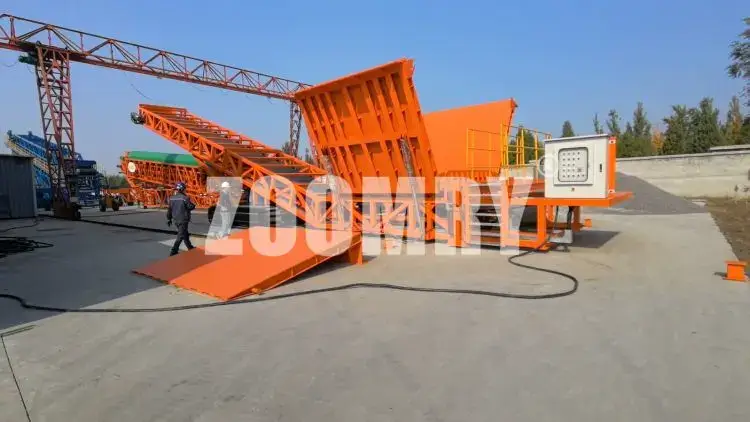Time:2025-05-12 11:12:59 Number of Clicks:
A truck unloader is a heavy-duty industrial equipment specifically designed for rapid unloading of bulk materials. It employs an automated conveying system to directly transfer cargo from truck compartments to designated storage or transportation points (such as silos, conveyor belts, or vessels). As a critical hub in modern bulk material handling systems, its core function is to replace traditional manual or excavator unloading methods, achieving seamless material transfer from transport carriers to processing terminals.
During operation, after a truck enters the preset unloading station, the device precisely aligns with the cargo compartment via hydraulic lifting mechanisms. The material then flows through a guide chute into the conveying system and is ultimately delivered to the target location via an adjustable-height discharge arm—all without manual intervention and with zero material spillage or contamination. It is suitable for handling bulk materials like coal, ore, grain, and cement in scenarios such as ports, mining operations, and power plant supply systems.

Truck unloaders are mechanized systems that enable efficient transfer of bulk materials from transport vehicles to processing equipment. Compared to traditional manual unloading, their core advantages include:
Modern truck unloaders adopt a modular design philosophy, achieving high-efficiency operations through the coordinated operation of five core subsystems. This not only enhances equipment reliability but also allows flexible functional adjustments based on operational requirements.
The chassis features automatic leveling functionality, maintaining stability even on slightly inclined surfaces (up to 5° slope) to prevent material spillage during unloading.
This module interfaces with truck compartments and guides materials onto the conveyor, incorporating three key designs:
| Wear Component Performance Comparison | Traditional Manganese Steel Plate | New Alloy Liner |
|---|---|---|
| Surface Hardness (HB) | 300–350 | 450–500 |
| Impact Toughness (J/cm²) | 60 | 120 |
| Replacement Cycle (Hours) | 8,000 | 15,000 |
If you have any questions about truck unloaders, please contact us using the information below.
As the core of material handling, this system can achieve a maximum incline of 22°, lifting materials to silos up to 8 meters high or connecting to other conveying equipment:
| Component | Function Description |
|---|---|
| Conveyor Belt | Multi-layer rubber belt, 1.2–2.2m wide |
| Drive Motor | Dual-motor configuration ensures stability |
| Speed Control | Automatically adjusts belt speed based on material volume |
Breaking the limitations of traditional switch-type hydraulics, modern intelligent hydraulic systems offer two critical functions:
IoT technology enables convenient operation and maintenance:
Based on operational scenarios and functional characteristics, truck unloaders are categorized into five main types, each offering tailored solutions for specific requirements.
Wheeled Truck Unloader features heavy-duty pneumatic or solid rubber tires, ideal for rapid relocation on flat, hardened surfaces (e.g., port yards, cement plants). Its standout feature is station switching via tow vehicles, typically completed within 30 minutes, with self-propelled speeds of 15–20 km/h within facilities. Hydraulic outriggers stabilize the unit during operation, achieving capacities of 200–1,800 tons/hour—making it a common choice for dry bulk materials like grain and coal.
Tracked Truck Unloader employs an all-terrain tracked chassis, specifically suited for rugged environments like mines and quarries. Wide tracks reduce ground pressure to below 0.3 kg/cm², ensuring stability even on muddy, rocky, or 15° slopes. Built-in collision sensors automatically halt operations when obstacles are within 30 cm, ensuring safety in confined mining pits. Typical applications include handling dense materials like iron ore and bauxite in open-pit mining.
Radial Truck Unloading System features a 270° rotating discharge arm with telescopic mechanisms covering a 15–25m radius. Commonly used in power plants and chemical facilities, it auto-aligns with various truck models via preset programs. Laser positioning ensures cargo compartment alignment within <5 cm error margins, ideal for mixed logistics scenarios requiring multi-vehicle compatibility.
Designed for ultra-heavy haul trucks (e.g., 100-ton mining trucks), this solution uses dual hydraulic cylinders to tilt the platform 60°, leveraging gravity for rapid unloading. The corrugated anti-slip steel platform supports up to 150 tons, reducing unloading cycles to 8–12 minutes per truck. Widely used in large-scale mining projects for handling lumpy, non-free-flowing ores.
Customized models for extreme conditions include three variants:
Key challenges include high-volume material handling while controlling environmental pollution. Wheeled unloaders with enclosed conveyors are preferred, featuring adjustable discharge arms for direct ship loading or stacking—minimizing open-air storage losses and dust dispersion. Hardened-surface tires enable flexible movement in congested areas like container yards.
Rugged terrain and dense materials demand high mobility and impact resistance. Tracked unloaders with vibratory breakers prevent blockages, while reinforced wear plates extend component life in abrasive conditions. Collision sensors ensure safety in narrow mining pits.
Continuous operation and safety are paramount. Fixed radial systems with 270° rotation arms and heat-resistant belts auto-adjust feed rates based on boiler demand. Spark detection and anti-static materials mitigate fire risks in coal dust environments.
Sticky materials like limestone require flip-plate designs with Teflon-coated belts to minimize buildup. Enclosed structures and negative-pressure dust control comply with environmental standards. Hot-air systems maintain ramp dryness for consistent flow.
Zoomry recommends predictive maintenance via IoT sensors, achieving:
Copyright © 2002-2024 Zoomry Group Company Limited